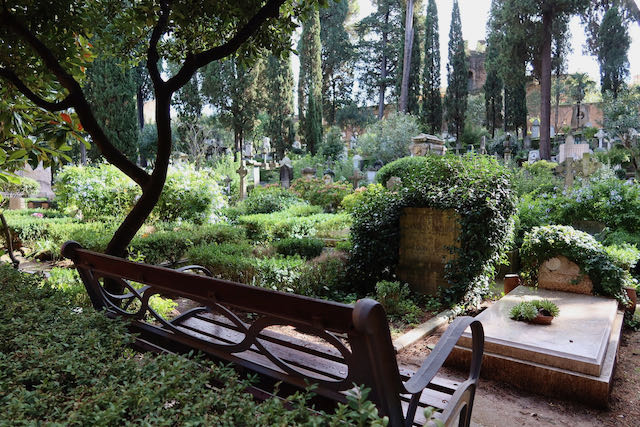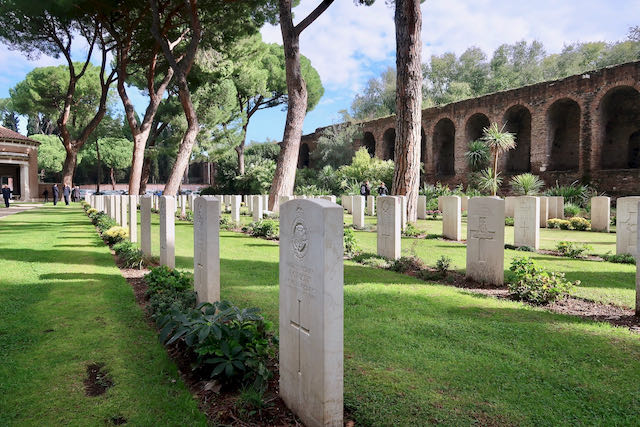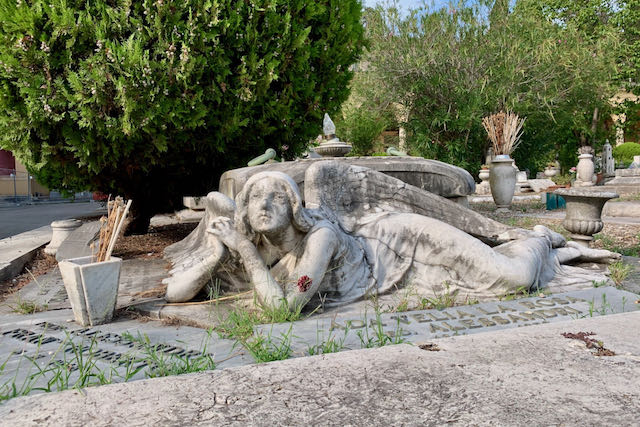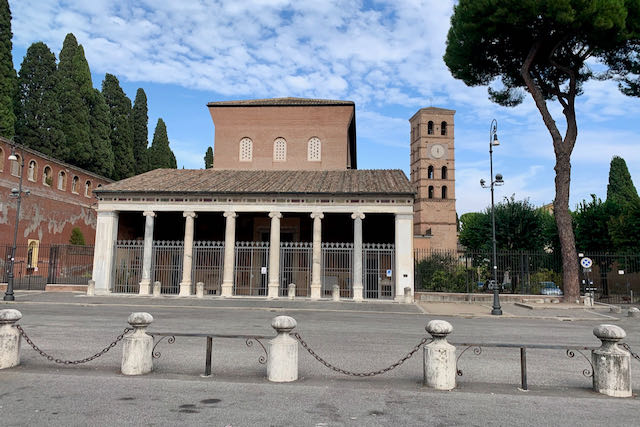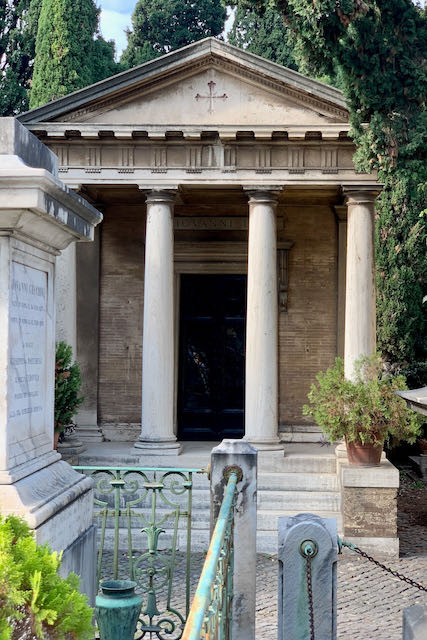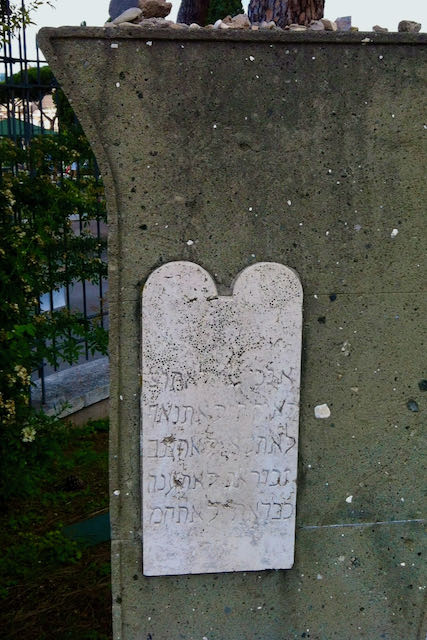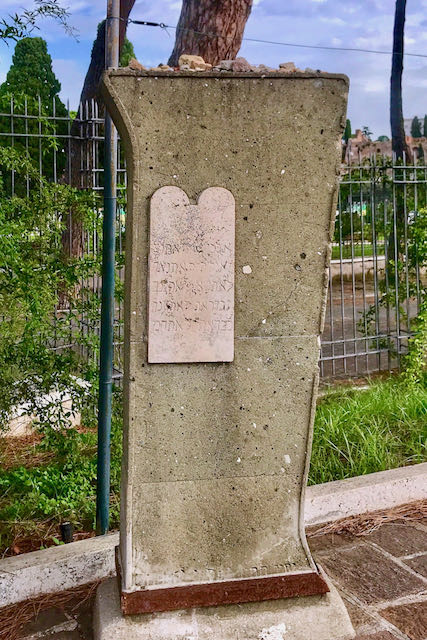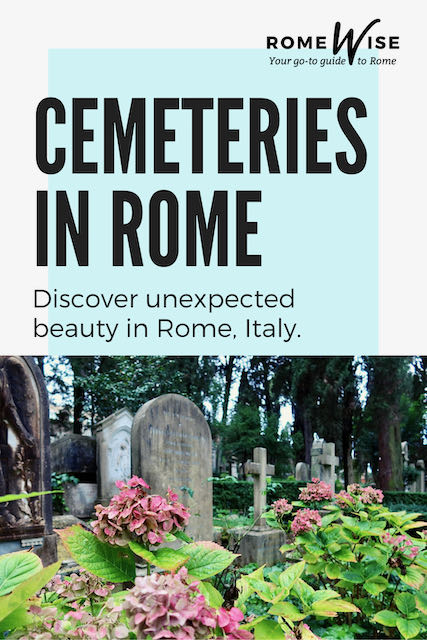- Sign up & get a FREE ebook Subscribe NOW!
- Romewise Home Page
- What to Do in Rome
- Romantic Things to Do in Rome
- Cemeteries in Rome
Cemeteries in Rome - Unusual Thing to Do
Visiting cemeteries in Rome may not be what you had in mind when you planned your trip here, especially if it’s your first visit.
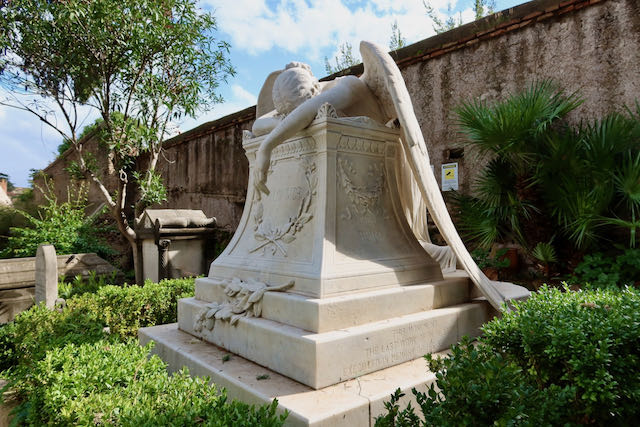 One of the most famous tombs in Rome's Protestant cemetery is the "Angel of Grief," created by the American sculptor W. W. Story for his wife, Emelyn.
One of the most famous tombs in Rome's Protestant cemetery is the "Angel of Grief," created by the American sculptor W. W. Story for his wife, Emelyn.But Rome has some special, beautiful cemeteries, and they offer a place for peace and quiet, reflection, and often, just a lovely and unusual site to see.
Cemeteries in Rome – we have more than you might think!
Being Rome, of course we have a lot of really famous ancient tombs, like the tomb of Saint Peter, the tomb of the baker (pictured below), and the tomb of Gaius Cestius, also known as the pyramid (see below.)
There are also two enormous imperial mausoleums – Augustus’ mausoleum, and Hadrian’s mausoleum, today known as Castel Sant’Angelo.
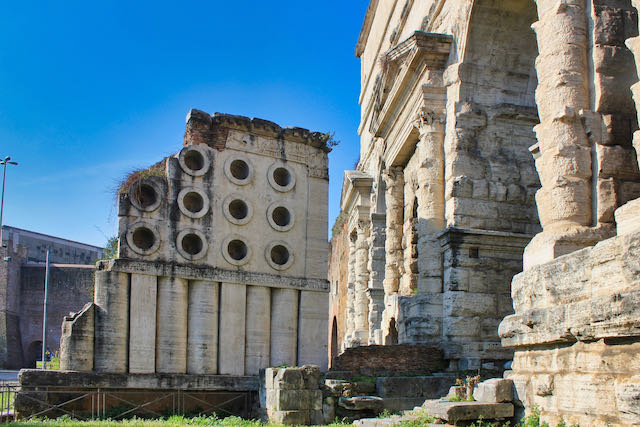 The Baker's Tomb at Porta Maggiore is one of the more unusual tombs we have from Ancient Rome. But we also have a lot of beautiful and fascinating contemporary cemeteries in Rome that you can visit.
The Baker's Tomb at Porta Maggiore is one of the more unusual tombs we have from Ancient Rome. But we also have a lot of beautiful and fascinating contemporary cemeteries in Rome that you can visit.And aside from famous ancient tombs, Rome boasts miles and miles (or kilometers and kilometers) of catacombs, underground burial sites for the dead of Ancient Rome.
💀 Discover the secrets of Rome's catacombs and most famous crypt 💀
Venture into ancient catacombs where early Christians found refuge, walk along the historic Appian Way, and brace yourself for the eerie Capuchin crypt—a unique reminder of life's fragility, adorned with monks' bones.
With comfortable minibus transport, this is a memorable dive into Rome’s mysterious past.
And let’s not forget everyone’s favorite crypt in Rome, the Cappuchin Crypt (museo cappuccini), decorated with the bones of thousands of monks from 17th century.
Cemeteries in Rome (and near Rome) that you can visit
For this page, I want to share with you the most interesting contemporary cemeteries in Rome.
They can be beautiful places to enjoy some quiet time, and to see something a bit unusual and off the beaten track.
I’ve visited them all and trust me, each one deserves a closer look:
- Non-Catholic Cemetery /Protestant Cemetery
- Rome War Cemetery - Commonwealth War Graves
- Campo Verano Cemetery
- Sicily-Rome American Cemetery and Memorial in Nettuno
- Roseto Rose Garden
- Teutonic Cemetery inside Vatican City
- Mausoleo Ossario Garibaldino on the Gianiculum Hill
This is not by any means a list of all the cemeteries in Rome, but they are the ones I think you will find most fascinating to visit.
Non-Catholic Cemetery/Protestant Cemetery
This cemetery is nicknamed the Protestant Cemetery or the Englishmen’s Cemetery in Rome, but it’s more officially known as the non-Catholic Cemetery in Rome, (Cimitero Acatolico in Italian.)
None of these monikers is entirely correct.
The cemetery does contain the graves of many non-Catholic Englishmen, but there are also graves of people of all different faiths and nationalities.
The bottom line is that it’s a simply beautiful cemetery with a lot of famous residents and beautiful tombs.
A short history of the protestant cemetery in Rome
Why does Rome have a cemetery for non-Catholics?
And why is there a pyramid inside it?
The pyramid is an Egyptian style tomb built by a wealthy Roman name Caius Cestius around 12 - 18 BCE.
It later became incorporated into the Aurelian Walls in the 3rd century.
So, it’s just chance that this ancient tomb happens to seem to be part of this more contemporary cemetery.
It's even possible to visit the pyramid.
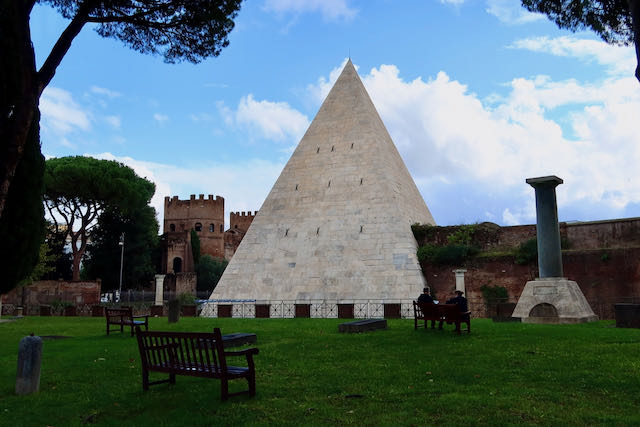 Sitting in a quiet green space with this beautiful ancient Roman monument to look at is one of the joys of visiting this cemetery in Rome.
Sitting in a quiet green space with this beautiful ancient Roman monument to look at is one of the joys of visiting this cemetery in Rome.Pope Clement XI (1700 – 1721) donated the land in 1716, presumably to give “non-believers” a place to be properly buried since they could not be buried in cemeteries in Rome that were for Catholics only.
This was the beginning of the era of "the Grand Tour", and many people were visiting Rome from other countries and if they died in Rome, would need a place of burial.
The first known burial here was in 1738.
A young student from Oxford had died after falling from his horse.
As a non-Catholic foreigner, he was buried at the edge of the city walls.
Other non-Catholic foreigners who died in Rome were soon buried there as well, and the area became a de facto cemetery.
With over 4,000 graves, it is still in use today.
I think of this as a beautiful place to wander, very slowly, and absorb all the beauty around me.
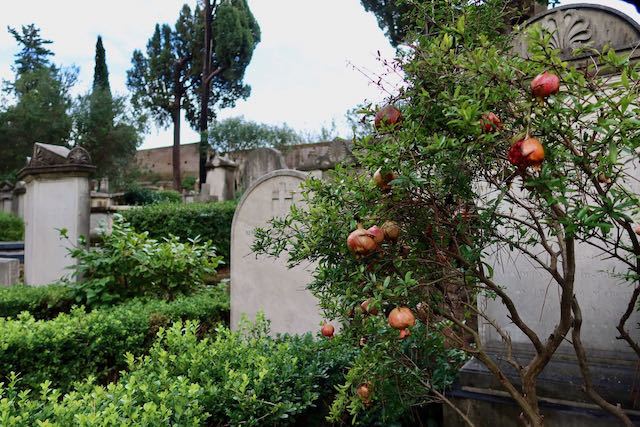 The Protestant cemetery feels in many ways like a secret garden, full of magnolia, pomegranate, and cypress trees.
The Protestant cemetery feels in many ways like a secret garden, full of magnolia, pomegranate, and cypress trees.Protestant cemetery Rome cats
There is an official cat colony inside this cemetery, so you will often see them wandering about the grounds.
The cats are well cared for so they are serene, adding to the sense of languor.
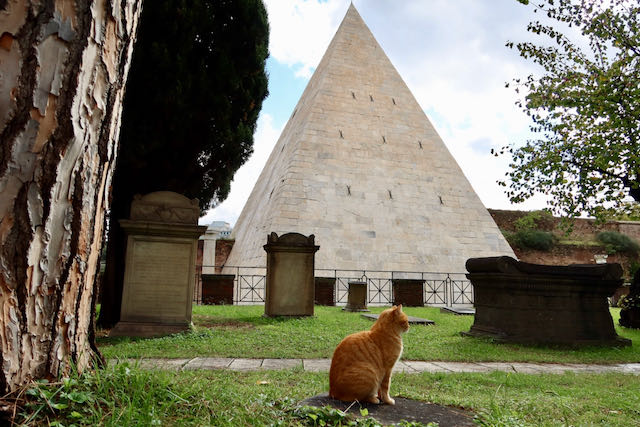 Why is this one of my favorite of all the cemeteries in Rome? One word - cats! But I do love the pyramid, too!
Why is this one of my favorite of all the cemeteries in Rome? One word - cats! But I do love the pyramid, too!On the other hand, it’s not so easy to just stroll aimlessly.
The beautiful, sometimes extremely artistic and expressive tombs will draw your eye towards them, and it’s impossible not to be moved by some of the beautiful dedications.
💀 Walk Through Ancient Ruins and Catacombs 💀
Uncover ancient history with these fascinating tours!
Visit the captivating ruins of Ostia Antica and explore the mysterious catacombs along the Appia Antica, for a journey back in time.
Famous Graves in Rome
Perhaps the two most famous residents of this cemetery are the romantic English poets John Keats and Percy Bysshe Shelley.
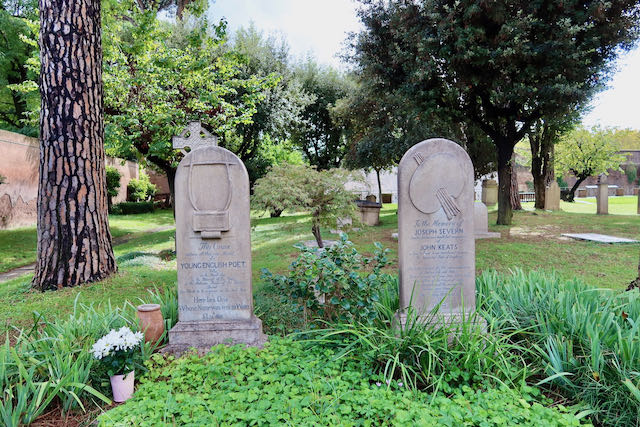 Keats grave in Rome - his tomb does not name him, but at his request, his epitaph says: “Here lies one whose name was writ in water.”
Keats grave in Rome - his tomb does not name him, but at his request, his epitaph says: “Here lies one whose name was writ in water.”Keats was 25 when he died of tuberculosis in Rome in 1821.
(You can visit his house next to the Spanish Steps.)
Shelley was 29 when he drowned in 1822 in a sailing accident off the Italian Riviera.
Several years before he died, Shelley had written this about the cemetery:
"It might make one in love with death, to think that one should be buried in so sweet a place."
Shelley was married to another famous author, Mary Shelley.
While she is not buried in the cemetery, their 3-year old son William, who died at age 3 of malaria, is buried here.
Shelley's gravestone contains a quote from Shakespeare’s The Tempest:
“Nothing of him that doth fade,
But doth suffer a sea change,
Into something rich and strange.”
Other famous burials include Antonio Gramsci (founder of the Italian Communist party), Goethe's son, Gregory Corso /Beat poet), and, most recently, one of my favorite authors, Andrea Camilleri.
You can read about some of the notable people buried here on their website.
While I love a quiet stroll here, I've also taken a tour and that is definitely worthwhile.
Rome War Cemetery - Commonwealth War Graves
While the non-Catholic cemetery in Rome is fairly well-known, not many people know of the smaller cemetery only a few meters away.
One of several war memorial cemeteries in Rome, the Rome War Cemetery was begun during WWII to accommodate the Commonwealth war dead.
When you approach the entrance to the cemetery, you will find it padlocked (to keep out vandals and vagrants).
Use the combination 1221 to enter.
Usually, when I visit, I find gardeners working there.
It seems to me to be one of the best-kept gardens in all of Rome.
You will also find a piece of Hadrian’s Wall here.
This is ironic as the piece of Roman Emperor Hadrian’s wall came to Rome all the way from England and is juxtaposed against the Aurelian Wall.
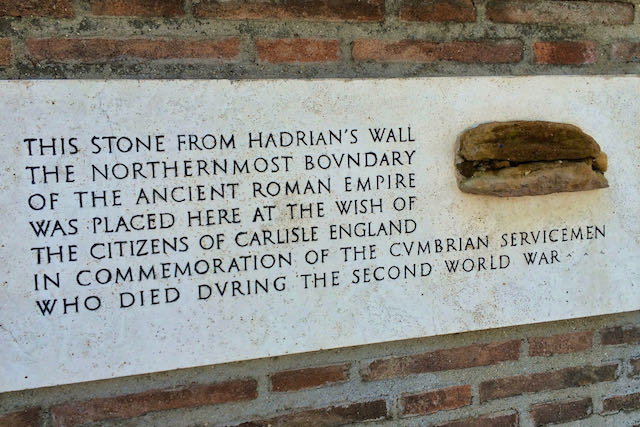 A fragment of brick from Hadrian's Wall was brought from Great Britain to Rome and walled up in a tombstone in the Commonwealth War Cemetery in memory of the soldiers from Cumbria died in the WWII
A fragment of brick from Hadrian's Wall was brought from Great Britain to Rome and walled up in a tombstone in the Commonwealth War Cemetery in memory of the soldiers from Cumbria died in the WWIIOn Remembrance Day, November 11, there is a commemorative service, usually attended by all the Commonwealth Ambassadors as well as other dignitaries in Rome.
There is a similar service on April 25, Anzac Day.
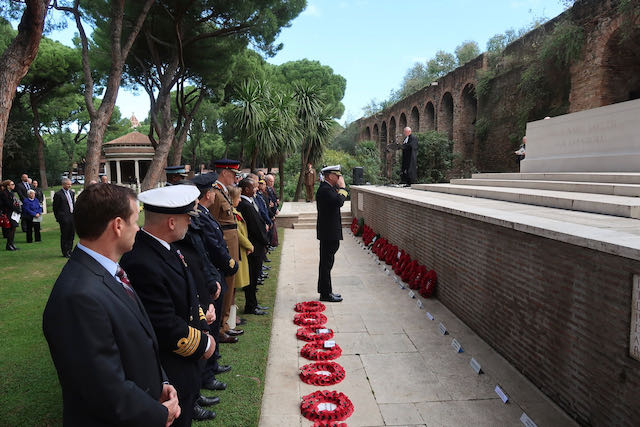 As someone who lives in Rome, I'm grateful to be able to participate in events like this one on Remembrance Day, November 11, which honor war dead.
As someone who lives in Rome, I'm grateful to be able to participate in events like this one on Remembrance Day, November 11, which honor war dead.Wheelchair access to the cemetery is possible; enquiries@cwgc.org
Address: Via Nicola Zabaglia, 50
Hours: Monday - Friday: 8 am - 3 pm
Visit the official website here
The perfect 3-day itinerary in Rome
Trying to figure out how to organize your visit to Rome? I've got the perfect 3-day itinerary for first-time visitors (or those who have not been here in a while.) It works for a 2.5 day visit as well.
In my 3-day itinerary, you'll see all the major must-see Rome attractions like the Vatican, Colosseum, Trevi Fountain, Pantheon, Piazza Navona, Spanish Steps, and much more.
And if you have more time, or want suggestions for extra/other things to do, you'll find that there too.
Visit my page with the best 3-day itinerary in Rome for first-timers.
Campo Verano Cemetery
Another of the most visually interesting cemeteries in Rome is the Campo Verano Cemetery (Cimitero del Verano).
The area has been a burial site going back 2,000 years, as demonstrated by the Catacombs of Santa Ciriaca underneath the basilica of San Lorenzo Fuori le Mura just next door (they are not visitable but trust me, they are there.)
The cemetery you see today was established in the early 1800's, when Napoleon ruled Rome.
His favorite architect Giuseppe Valadier was the first architect (1807 to 1812).
It has since grown to be a vast cemetery with many different moods and architectural styles.
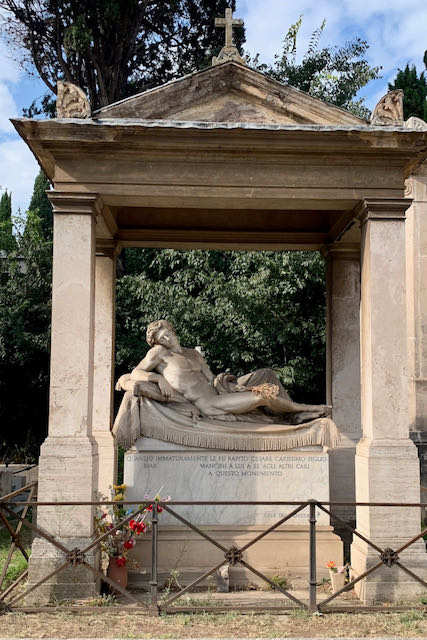 Funeral sculpture by Francesco Fabi Altini (1830 - 1906). The statue of a young man (a certain Cesare Mancini) naked and asleep. Completed between 1871 and 1875, it is considered one of the most beautiful works by Altini, having been commissioned "in memory of the beauty that the young man possessed in life" tragically ended at the age of twenty-nine.
Funeral sculpture by Francesco Fabi Altini (1830 - 1906). The statue of a young man (a certain Cesare Mancini) naked and asleep. Completed between 1871 and 1875, it is considered one of the most beautiful works by Altini, having been commissioned "in memory of the beauty that the young man possessed in life" tragically ended at the age of twenty-nine.It's so enormous and so varied that walking tours take 2 hours.
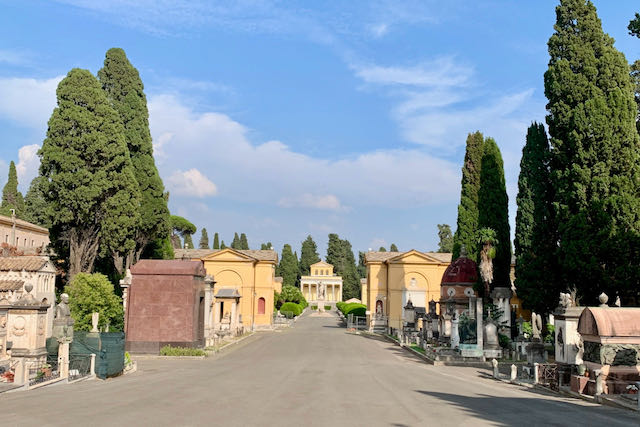 A visit to the Verano Cemetery is a true discovery of the architectural structure of its terrain. Its historical core is in fact a composite work, the result of three generations of architects and engineers, a creation of an hauntingly fascinating urban burial ground.
A visit to the Verano Cemetery is a true discovery of the architectural structure of its terrain. Its historical core is in fact a composite work, the result of three generations of architects and engineers, a creation of an hauntingly fascinating urban burial ground.Romans consider the Verano to be one of the most important cemeteries in Rome, if not the most important.
Many famous graves are here, including of actors, politicians, and war heroes.
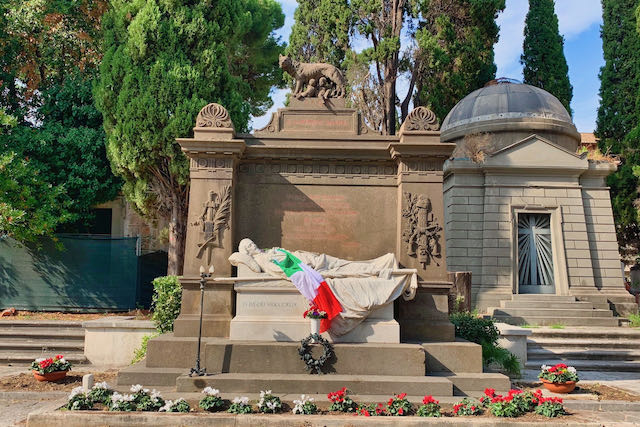 This memorial to Risorgimento hero Goffredo Mameli is not his actual grave. He is buried in the Ossario on the Gianicolo (see below.)
This memorial to Risorgimento hero Goffredo Mameli is not his actual grave. He is buried in the Ossario on the Gianicolo (see below.)Address: Piazzale del Verano, 1
Hours: Open daily 7.30 am - 6 pm
Visit the official website here
Sicily-Rome American Cemetery and Memorial in Nettuno
Not far from Rome is Anzio beach, site of one of the most important landings in WWII.
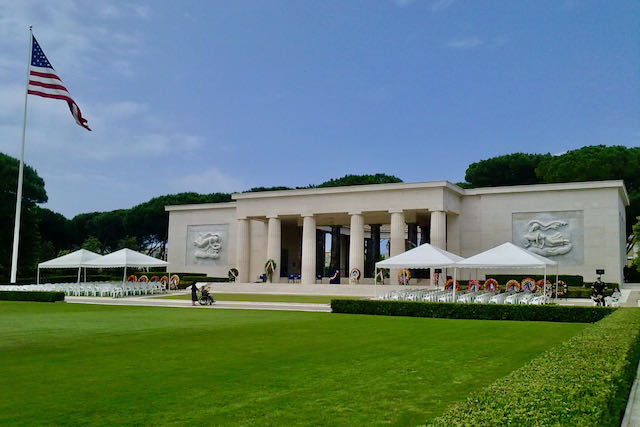 Sicily-Rome American Cemetery and Memorial in Nettuno, Italy is one of two cemeteries in Italy of American war dead.
Sicily-Rome American Cemetery and Memorial in Nettuno, Italy is one of two cemeteries in Italy of American war dead.It is therefore also the site of one of two cemeteries of American war dead in Italy (the other being Florence American Cemetery and Memorial site, just outside Florence.)
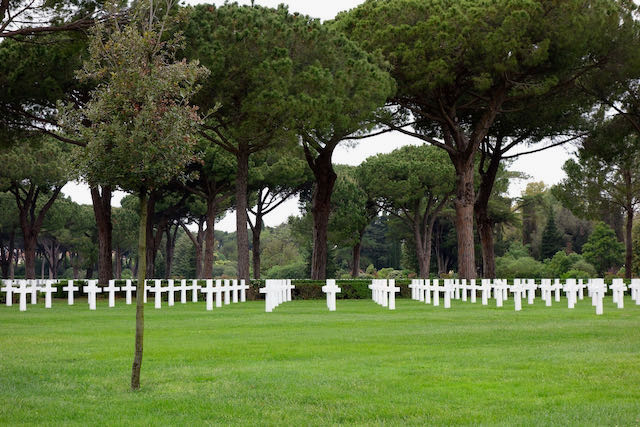 If you're looking for the Anzio beachhead cemetery, you're probably looking for this one, which is actually in the neighboring town of Nettuno.
If you're looking for the Anzio beachhead cemetery, you're probably looking for this one, which is actually in the neighboring town of Nettuno.Clearly this is not a cemetery in Rome per se, but it's close to Rome and is one of the places visitors ask me about quite often.
There is another WWII cemetery in this area, The Commonwealth of Nations Anzio War Cemetery, often called the English War Cemetery.
Address: Piazzale Kennedy, 1
Hours: Open daily 9 am - 5 pm
Visit the official website here
Disclosure: If you make a purchase through a link on this page, I may receive a small commission - at no extra cost to you.
Thank you for supporting my site!
Roseto Rose Garden
It may seem odd to include Rome’s beautiful Roseto Rose Garden (Roseto Comunale) on a page about visiting cemeteries in Rome.
But this is an unusual rose garden with an unusual history.
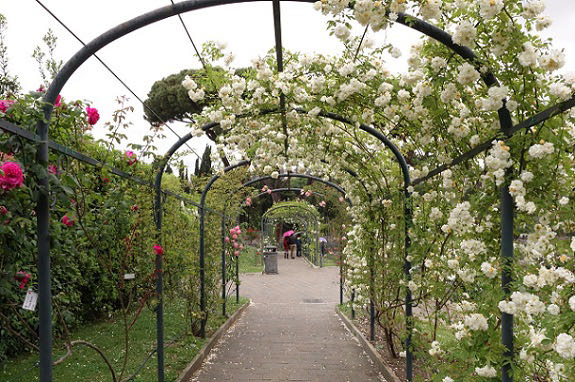 You'd never think while walking through these rose-covered trellises that you are in fact visiting one of the most important cemeteries in Rome in recent history.
You'd never think while walking through these rose-covered trellises that you are in fact visiting one of the most important cemeteries in Rome in recent history.From 1645, the Jewish community of Rome began using this area as their cemetery.
It was the Jewish Cemetery in Rome until 1934, when they were forced to sell it so the Fascist regime could create the via del Circo Massimo.
So, the Jewish community got permission to use a section of the monumental cemetery of Rome at Campo Verano (above.)
They were able to move 372 tombs and some of the more recent monuments to the Verano, but the move was done in haste, and hundreds of older graves remained undisturbed.
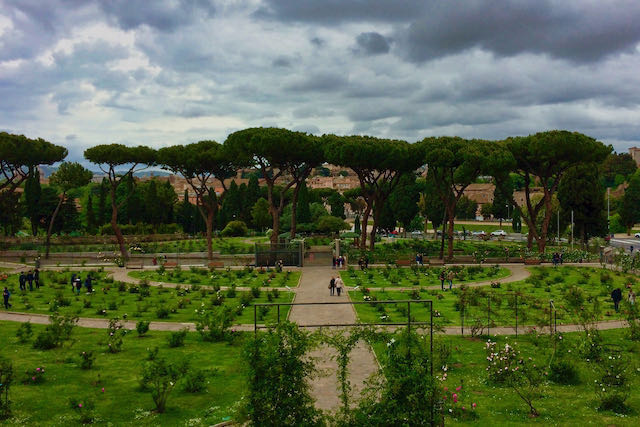 From the top of the Roseto Rose Garden in Rome, you can see the layout of the walkways in the shape of a menorah, to honor the Jewish cemetery that was once here.
From the top of the Roseto Rose Garden in Rome, you can see the layout of the walkways in the shape of a menorah, to honor the Jewish cemetery that was once here.So even today as you walk in the beautiful Roseto Rose Garden, you are in fact walking over the old Jewish Cemetery.
A sign at the entrance states that anyone with the name Coen should not enter as this is forbidden by Jewish Law.
In memory of the origins of this site, the walkways are in the shape of a 7-branch candelabra (like the one that was looted from the Temple of Jerusalem by the Flavians.)
You will also find a small monument showing the Tablets of Law at each of the two entrances.
Visitors often leave stones on top, which honors the memory of those buried here.
In 1931, American-born Countess Mary Gailey Senni, who married to an Italian aristocrat, came up with the idea and first design of the current rose garden, which included 300 roses.
Today there are over 1,100 roses and many varieties from around the world.
A contest is held each spring for the most beautiful rose.
Details: Open only from April 21 (Rome's birthday) through the first week of June, and in recent years, also the first two weeks of October.
Teutonic Cemetery inside Vatican City
One of the smallest and probably least well-known cemeteries in Rome is actually inside Vatican City.
Just past the gate of the Swiss Guard, there is a small, beautiful graveyard, the Campo Santo Teutonico, or Teutonic Cemetery.
Burial is reserved for members of the Confraternity of Our Lady of the German Cemetery, which owns the cemetery, and for members of German colleges and religious houses in Rome.
In February 2015, Pope Francis approved the burial of a homeless Flemish man, Willy Herteleer.
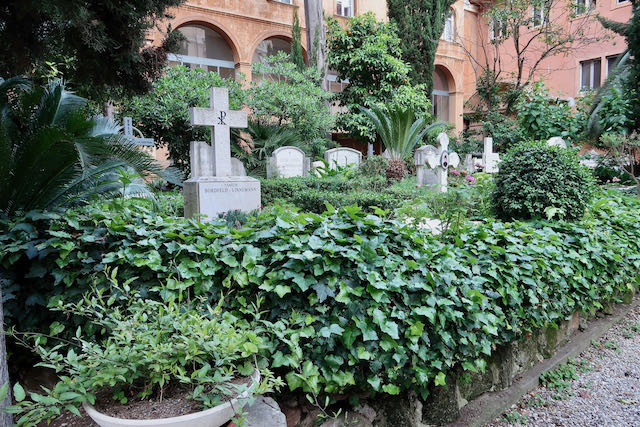 The Campo Santo Teutonico cemetery is lovely and small and feels like a secret because it kind of is.
The Campo Santo Teutonico cemetery is lovely and small and feels like a secret because it kind of is.It is available to visit but it’s not easy.
You need to come between 9am - 12pm, and you must ask the Swiss Guard if you can visit the cemetery.
I once heard you had to ask them in Dutch or German but I believe you can ask in another language as well.
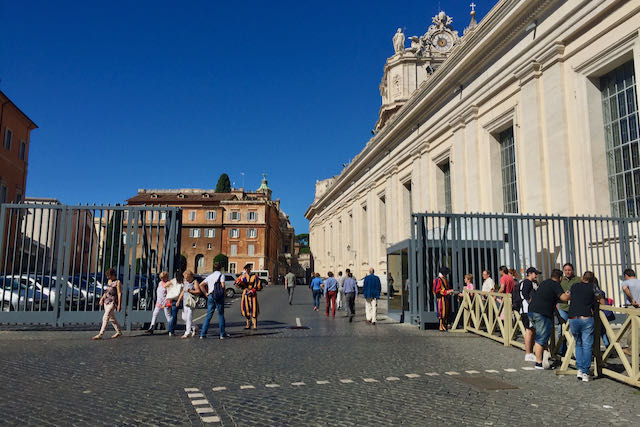 At the same entrance for visiting Saint Peter's tomb, you can ask the Swiss Guard for permission to visit the Teutonic cemetery.
At the same entrance for visiting Saint Peter's tomb, you can ask the Swiss Guard for permission to visit the Teutonic cemetery.Address: Via di Porta Cavalleggeri, 7891, 00165 IT, 00120 Roma, Vatican City
Hours: Thursday - Tuesday: 9 am - 12 pm.
Closed on Wednesday.
Visit the official website here
Mausoleo Ossario Garibaldino on the Gianiculum Hill
High on the Janiculum Hill overlooking Rome, you will find an imposing equestrian statue of Giuseppe Garibaldi, the famed Italian general and leader of the Italian “Risorgimento”, which was a long-fought war for the unification of Italy.
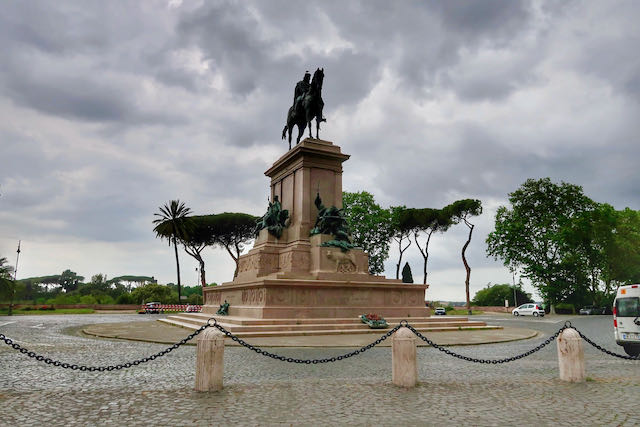 The statue of Risorgimento leader Giuseppe Garibaldi stands high on the Gianicolo Hill overlooking Rome.
The statue of Risorgimento leader Giuseppe Garibaldi stands high on the Gianicolo Hill overlooking Rome.The statue is in a “Piazzale”, or round plaza, and from there you can wander past the Eucalyptus trees to visit the “Big Fountain.”
All this quiet beauty seems an unusual place to have a cemetery, but it was in fact one of the sites of the bloodiest battles fought for Rome’s liberation.
Just past the Big Fountain you will come to a Fascist-style monument (inaugurated in 1941), called the Ossario, or bone-repository (yes it sounds much more elegant in Latin.)
The Mausoleum houses the remains of those who died in the battles for Rome between 1849 to 1870.
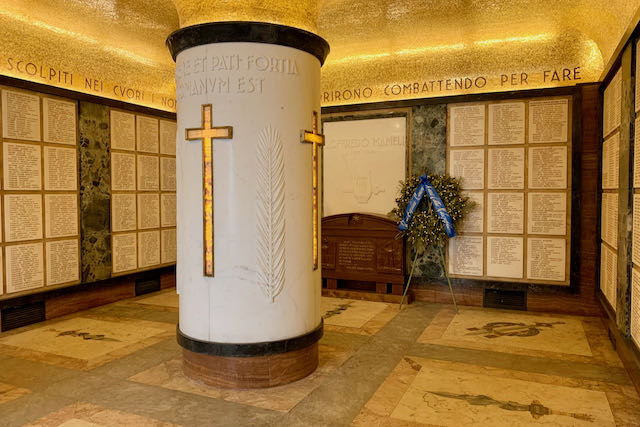 The Garibaldi Ossuary Mausoleum is located in the Gianicolo Historical Park and houses the remains of the fallen in the battles for the independence of Rome from 1849 to 1870.
The Garibaldi Ossuary Mausoleum is located in the Gianicolo Historical Park and houses the remains of the fallen in the battles for the independence of Rome from 1849 to 1870.One of the most famous graves in this Rome cemetery is that of Goffredo Mameli, a young Genoese poet, who was wounded nearby in 1849.
He died of his injuries at the age of only 22.
Address: Mausoleo Ossario Garibaldino, Via Garibaldi, 29
Hours: Open on Thursdays 10.30 am – 12.30 pm.
Visit the official website here
Ready to plan your trip?
Book your train
Planning to travel between cities in Italy and other parts of Europe?
Use Trainline to see all the different options available across the different rail companies.
Find your hotel
Find your perfect place to stay in Rome.
Use Booking.com to choose between hotels, guesthouses, and self-catering apartments in neighborhoods throughout the Eternal City.
Buy your TurboPass
Purchase the convenient Turbopass and visit all of Rome's top attractions including the Colosseum, Pantheon, and Vatican.
With one handy pass, it's all included.
Cemeteries in Rome/near Rome - a map
It will open in a new window.
Romewise's Top Travel Resources
Ready to book your trip to Rome? Take a look at these helpful links to companies we use and trust:
- Keep your travel spending simple with the Wise card, which removes all the worry about exchange rates and high transaction fees all over the world
- Search for and book your perfect accommodation
- Our complete guide to what to pack for Rome
- The number one travel accessory, a multi-point travel adapter and voltage converter
- Browse a huge range of tours in Rome and beyond
- Experience unique tours and special access to Rome's most popular sights
- Protect yourself with comprehensive travel insurance
Within this post there are some affiliate links for products and services. For more details about our affiliate policy click here.
Get your 100% free Rome trip planner now!
Simply sign-up today for our free newsletter and get the Romewise Quick Start guide to Rome:
We are committed to respecting your data. Click for our Privacy Policy.
Comments? Questions? Suggestions?
Please come over to the private Romewise Facebook group and join in the conversation.
You will often find me there, happy to answer your questions / comments!
You will also meet other Rome lovers and experts, too.
What are you waiting for?
- Romewise Home Page
- What to Do in Rome
- Romantic Things to Do in Rome
- Cemeteries in Rome

